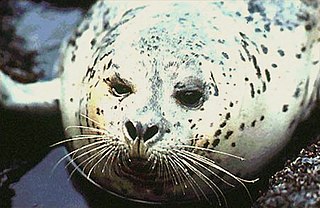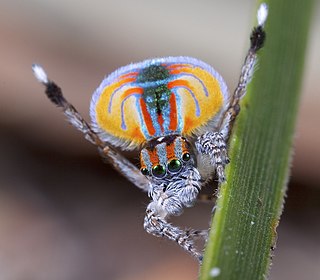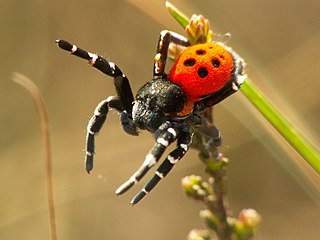
Sexual selection is a mode of natural selection in which members of one biological sex choose mates of the other sex to mate with, and compete with members of the same sex for access to members of the opposite sex. These two forms of selection mean that some individuals have greater reproductive success than others within a population, for example because they are more attractive or prefer more attractive partners to produce offspring. Successful males benefit from frequent mating and monopolizing access to one or more fertile females. Females can maximise the return on the energy they invest in reproduction by selecting and mating with the best males.

Sexual dimorphism is the condition where sexes of the same species exhibit different morphological characteristics, particularly characteristics not directly involved in reproduction. The condition occurs in most animals and some plants. Differences may include secondary sex characteristics, size, weight, color, markings, or behavioral or cognitive traits. Male-male reproductive competition has evolved a diverse array of sexually dimorphic traits. Aggressive utility traits such as "battle" teeth and blunt heads reinforced as battering rams are used as weapons in aggressive interactions between rivals. Passive displays such as ornamental feathering or song-calling have also evolved mainly through sexual selection. These differences may be subtle or exaggerated and may be subjected to sexual selection and natural selection. The opposite of dimorphism is monomorphism, when both biological sexes are phenotypically indistinguishable from each other.
The Coolidge effect is a biological phenomenon seen in animals, whereby males exhibit renewed sexual interest whenever a new female is introduced, even after sex with prior but still available sexual partners. To a lesser extent, the effect is also seen among females with regard to their mates.

Animal communication is the transfer of information from one or a group of animals to one or more other animals that affects the current or future behavior of the receivers. Information may be sent intentionally, as in a courtship display, or unintentionally, as in the transfer of scent from predator to prey with kairomones. Information may be transferred to an "audience" of several receivers. Animal communication is a rapidly growing area of study in disciplines including animal behavior, sociology, neurology and animal cognition. Many aspects of animal behavior, such as symbolic name use, emotional expression, learning and sexual behavior, are being understood in new ways.

Phoca is a genus of the earless seals, within the family Phocidae, source of the French name for seal, 'phoque'. It now contains just two species, the common seal and the spotted seal. Several species formerly listed under this genus have been split into the genera Pusa, Pagophilus, and Histriophoca. Until recently, Phoca largha has been considered a subspecies of Phoca vitulina but now is considered its own species. For this reason, the fossil history of the genus is unclear, and it has formerly been used as wastebasket taxon for a number of fossils of uncertain affinity.

Animal sexual behaviour takes many different forms, including within the same species. Common mating or reproductively motivated systems include monogamy, polygyny, polyandry, polygamy and promiscuity. Other sexual behaviour may be reproductively motivated or non-reproductively motivated.

Maratus volans is a species in the jumping spider family (Salticidae), belonging to the genus Maratus. These spiders are native to certain areas in Australia and occupy a wide distribution of habitats. They have a specialized visual system that allows them to see the full visible spectrum as well as in the ultraviolet-range; this helps them detect and pursue prey. Males of this species are characterized by their colourful abdomen flaps that are used to attract females during courtship.

Mate choice is one of the primary mechanisms under which evolution can occur. It is characterized by a "selective response by animals to particular stimuli" which can be observed as behavior. In other words, before an animal engages with a potential mate, they first evaluate various aspects of that mate which are indicative of quality—such as the resources or phenotypes they have—and evaluate whether or not those particular trait(s) are somehow beneficial to them. The evaluation will then incur a response of some sort.

Sexual cannibalism is when an animal, usually the female, cannibalizes its mate prior to, during, or after copulation. It is a trait observed in many arachnid orders and several insect orders. Several hypotheses to explain this seemingly paradoxical behavior have been proposed. The adaptive foraging hypothesis, aggressive spillover hypothesis and mistaken identity hypothesis are among the proposed hypotheses to explain how sexual cannibalism evolved. This behavior is believed to have evolved as a manifestation of sexual conflict, occurring when the reproductive interests of males and females differ. In many species that exhibit sexual cannibalism, the female consumes the male upon detection. Females of cannibalistic species are generally hostile and unwilling to mate; thus many males of these species have developed adaptive behaviors to counteract female aggression.

Padogobius is a genus of fish in the family Gobiidae, the gobies. They are native to fresh waters of southern Europe.

A courtship display is a set of display behaviors in which an animal, usually a male, attempts to attract a mate; the mate exercises choice, so sexual selection acts on the display. These behaviors often include ritualized movement ("dances"), vocalizations, mechanical sound production, or displays of beauty, strength, or agonistic ability.
A mating call is the auditory signal used by animals to attract mates. It can occur in males or females, but literature is abundantly favored toward researching mating calls in females. In addition, mating calls are often the subject of mate choice, in which the preferences of one gender for a certain type of mating call can drive sexual selection in a species. This can result in sympatric speciation of some animals, where two species diverge from each other while living in the same environment.

A dominance signal is used in a dominance hierarchy or pecking order to indicate an animal's dominance. Dominance signals are a type of internal environment signal that demonstrate the signalers attributes [2]. Dominance signals are necessary for several species for mating, maintaining social hierarchies and defending territories Dominance signals also provide information about an animals fitness. Animals have developed conflict management strategies to reduce frequency of aggressive incidents in competitive matters. This evolution is the basis of dominance signals[3].

Seismic or vibrational communication is a process of conveying information through mechanical (seismic) vibrations of the substrate. The substrate may be the earth, a plant stem or leaf, the surface of a body of water, a spider's web, a honeycomb, or any of the myriad types of soil substrates. Seismic cues are generally conveyed by surface Rayleigh or bending waves generated through vibrations on the substrate, or acoustical waves that couple with the substrate. Vibrational communication is an ancient sensory modality and it is widespread in the animal kingdom where it has evolved several times independently. It has been reported in mammals, birds, reptiles, amphibians, insects, arachnids, crustaceans and nematode worms. Vibrations and other communication channels are not necessarily mutually exclusive, but can be used in multi-modal communication.

The term seabird is used for many families of birds in several orders that spend the majority of their lives at sea. Seabirds make up some, if not all, of the families in the following orders: Procellariiformes, Sphenisciformes, Pelecaniformes, and Charadriiformes. Many seabirds remain at sea for several consecutive years at a time, without ever seeing land. Breeding is the central purpose for seabirds to visit land. The breeding period is usually extremely protracted in many seabirds and may last over a year in some of the larger albatrosses; this is in stark contrast with passerine birds. Seabirds nest in single or mixed-species colonies of varying densities, mainly on offshore islands devoid of terrestrial predators. However, seabirds exhibit many unusual breeding behaviors during all stages of the reproductive cycle that are not extensively reported outside of the primary scientific literature.
Female copulatory vocalizations, also called female copulation calls or coital vocalizations, are produced by female primates, including human females, and female non-primates. Copulatory vocalizations usually occur during copulation and are hence related to sexual activity. Vocalizations that occur before intercourse, for the purpose of attracting mates, are known as mating calls.

Sexual selection in amphibians involves sexual selection processes in amphibians, including frogs, salamanders and newts. Prolonged breeders, the majority of frog species, have breeding seasons at regular intervals where male-male competition occurs with males arriving at the waters edge first in large number and producing a wide range of vocalizations, with variations in depth of calls the speed of calls and other complex behaviours to attract mates. The fittest males will have the deepest croaks and the best territories, with females making their mate choices at least partly based on the males depth of croaking. This has led to sexual dimorphism, with females being larger than males in 90% of species, males in 10% and males fighting for groups of females.

Sexual selection in spiders shows how sexual selection explains the evolution of phenotypic traits in spiders. Male spiders have many complex courtship rituals and have to avoid being eaten by the females, with the males of most species survive a few matings, and having short life spans.
Agelenopsis pennsylvanica, commonly known as the Pennsylvania funnel-web spider or the Pennsylvania grass spider, is a species of spider in the family Agelenidae. The common name comes from the place that it was described, Pennsylvania, and the funnel shape of its web. Its closest relative is Agelenopsis potteri.
The sensory trap hypothesis describes an evolutionary idea that revolves around mating behavior and female mate choice. It is a model of female preference and male sexual trait evolution through what is known as sensory exploitation. Sensory exploitation, or a sensory trap is an event that occurs in nature where male members of a species perform behaviors or display visual traits that resemble a non-sexual stimulus which females are responsive to. This tricks females into engaging with the males, thus creating more mating opportunities for males. What makes it a sensory trap is that these female responses evolved in a non-sexual context, and the male produced stimulus exploits the female response which would not otherwise occur without the mimicked stimulus.

















